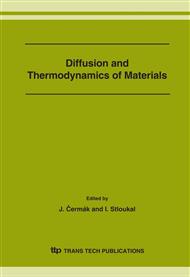p.11
p.21
p.31
p.41
p.51
p.57
p.63
p.69
p.75
Self-Diffusion in Covalent Amorphous Solids – A Comparative Study Using Neutron Reflectometry and SIMS
Abstract:
The self-diffusion of nitrogen is studied in amorphous silicon nitride, which is a model system for a covalently bound amorphous solid with a low atomic mobility where reliable diffusion data are still lacking. Comparative experiments on Si14Nx/Si15Nx (x ≈ 1.33) isotope multilayers were carried out with secondary ion mass spectrometry (SIMS) and neutron reflectometry (NR), respectively. It was found that experiments with SIMS are not very well suited for the determination of diffusivities in a broad temperature range. The minimum diffusion length of about 5-10 nm detectable with this method is too large. At high temperatures (> 1200 °C) the amorphous solid crystallizes before any diffusion is measured and at low temperatures (< 1100 °C) the diffusivities are too low to be detected. In contrast, with neutron reflectometry diffusion lengths in the order of 1 nm and diffusivities down to 10-24 m2 s-1 were measured between 950 and 1250 °C. The potential of this method for the determination of ultra slow diffusion processes is discussed.
Info:
Periodical:
Pages:
51-56
Citation:
Online since:
March 2007
Authors:
Price:
Сopyright:
© 2007 Trans Tech Publications Ltd. All Rights Reserved
Share:
Citation:


